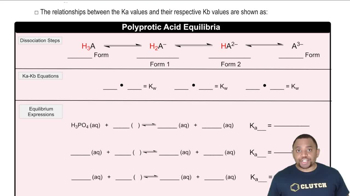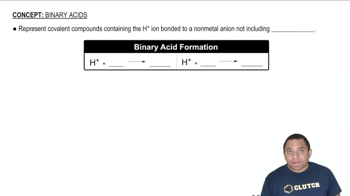Here are the essential concepts you must grasp in order to answer the question correctly.
Equilibrium Constant (K)
The equilibrium constant (K) is a numerical value that expresses the ratio of the concentrations of products to reactants at equilibrium for a given chemical reaction. It provides insight into the extent of the reaction; a large K indicates that products are favored, while a small K suggests that reactants are favored. In this context, K is used to relate the acid-base properties of the substances involved.
Recommended video:
Acid-Base Equilibrium
Acid-base equilibrium involves the balance between acids and bases in a solution, characterized by their dissociation constants (Ka for acids and Kb for bases). The relationship between Ka and Kb for a conjugate acid-base pair is given by the equation Kw = Ka × Kb, where Kw is the ion product of water. Understanding this relationship is crucial for calculating Kb from the given Ka.
Recommended video:
Triprotic Acid Equilibrium
Boric Acid and Caffeine Interaction
Boric acid (H3BO3) is a weak acid, and caffeine (C8H10N4O2) can act as a weak base. The neutralization reaction between an acid and a base leads to the formation of water and a salt, and the equilibrium constant for this reaction can be expressed in terms of the acid's dissociation constant (Ka) and the base's dissociation constant (Kb). This interaction is essential for determining the Kb of caffeine using the provided equilibrium constant for the reaction.
Recommended video:
 Verified step by step guidance
Verified step by step guidance

